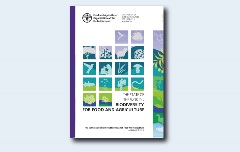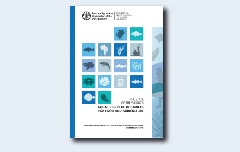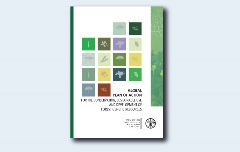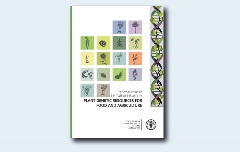The State of the World
The state of the world reports provide a comprehensive picture of the global situation and trends of biodiversity, including genetic resources, for food and agriculture.The reports are all undertaken with active participation of member countries as well as the public and private sectors. They provide information on the various topics for action, which will serve countries to set future priorities, at the national, regional and international levels for the conservation and sustainable utilization.

The State of the World’s Biodiversity for Food and Agriculture
The State of the World’s Biodiversity for Food and Agriculture presents the first global assessment of biodiversity for food and agriculture worldwide. Biodiversity for food and agriculture is the diversity of plants, animals and micro-organisms at genetic, species and ecosystem levels, present in and around crop, livestock, forest and aquatic production systems. It is essential to the structure, functions and processes of these systems, to livelihoods and food security, and to the supply of a wide range of ecosystem services. It has been managed or influenced by farmers, livestock keepers, forest dwellers, fish farmers and fisherfolk for hundreds of generations.

The State of the World’s Aquatic Genetic Resources for Food and Agriculture
The State of the World’s Aquatic Genetic Resources for Food and Agriculture represents a snapshot of the present status of AqGR and forms a valuable technical reference document, particularly where it presents standardized key terminology and concepts. There is little doubt that the process of preparing the global Report and the work done within countries to prepare Country Reports has improved the level of understanding and awareness of the vital importance of AqGR. The Report thus represents the first step in building a broad knowledge base on AqGR as a basis for future actions towards improved conservation, sustainable use and development of these valuable resources, at national, regional and global levels.

The State of the World’s Forest Genetic Resources
The State of the World’s Forest Genetic Resources recognizes that forest genetic resources make an important contribution to sustainable development through the provision of timber, food, fuel and various environmental services. The report assesses the status and trends of forest genetic resources at global level, based on country reports and regional syntheses. The themes covered in the report include the state of the conservation and management of forest genetic resources, trends affecting the forest sector and their implications for genetic resources, institutional and policy frameworks for the conservation and management of forest genetic resources, the state of knowledge of current and emerging technologies, and future needs and required responses. The preparation of the report assisted in the identification of the priorities reflected in the Global Plan of Action for the Conservation, Sustainable Use and Development of Forest Genetic Resources.

The State of the World’s Plant Genetic Resources for Food and Agriculture
In 1996, the first report on The State of the World’s Plant Genetic Resources for Food and Agriculture was welcomed by 150 countries at the Leipzig International Technical Conference on Plant Genetic Resources as the first comprehensive worldwide assessment of the status and use of plant genetic resource conservation and use. The conference also adopted the Global Plan of Action for the Conservation and Sustainable Utilization of Plant Genetic Resources for Food and Agriculture.In 2009, at its Twelfth Regular Session, the Commission endorsed The Second Report on the State of the World’s Plant Genetic Resources for Food and Agriculture as the authoritative assessment on the sector. The second report is an update of the first report (see below) and identifies the most significant changes that occurred between 1996, when the first report was published, and 2009. It analyses the status and trends of plant genetic resources and their use, in situ management and ex situ conservation. It also addresses the state of relevant programmes, training needs and legislation at national level. It discusses regional and international collaboration in the management of plant genetic resources, taking into account the question of access to these resources and the sharing of benefits derived from their use, as well as the contributions that their sustainable use makes to food security and poverty alleviation. It also looks at the role of plant genetic diversity in sustainable agriculture and the provision of ecosystem services. For each of the main subjects addressed, the report includes an analysis of gaps and needs. The report provided the basis for the development of the Second Global Plan of Action for Plant Genetic Resources for Food and Agriculture.

The State of the World’s Animal Genetic Resources for Food and Agriculture
The first report on The State of the World’s Animal Genetic Resources for Food and Agriculture, based on 169 country reports and published in 2007, provides an analysis of the status and trends of animal genetic resources and their management at national, regional and global levels, and identifies gaps and priorities for action. It addresses the following main areas: the state of agricultural biodiversity in the livestock sector; livestock-sector trends; the state of capacities to manage animal genetic resources; the state of the art in the management of animal genetic resources; and needs and challenges in animal genetic resources management. It was launched at the International Technical Conference on Animal Genetic Resources for Food and Agriculture, held in Interlaken, Switzerland, in 2007, and was subsequently welcomed by the FAO Conference as the first comprehensive worldwide assessment of the state of animal genetic resources. Priorities identified during the reporting process provided the basis for the development of the Global Plan of Action for Animal Genetic Resources.The Second Report on the State of the World’s Animal Genetic Resources for Food and Agriculture was launched by FAO in 2015. This report, which draws on 129 country reports, is an update of the first report and therefore focuses on developments since 2007 when the first report was published. It reviews the state of implementation of the Global Plan of Action for Animal Genetic Resources, along with outcomes in terms of the status and trends of livestock biodiversity. It summarizes the state of development of methods and strategies for managing animal genetic resources and trends in the livestock sector and their effects on animal genetic resources. Based on these assessments, the report identifies gaps in the management of animal genetic resources and priority actions to address these gaps.

